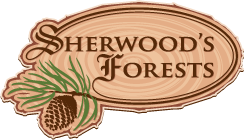
Wintercheeks -- Red with a white bloom. Sweet, crisp. Good keeper. Zone 3. This is our first year selling Wintercheeks.
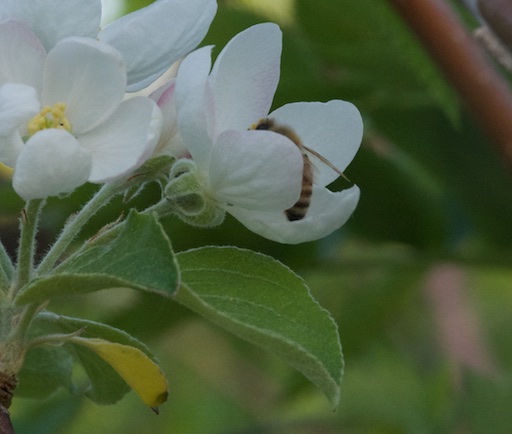
Honeybee in apple blossom.
Inventory tables are double rows to make them usable on small screens.
Common name and container in column 1.
Count is how many we think we have left. Price is per tree.
Height will be there next year, we hope.
Food -- Apple
| Common Name Container |
Count Price |
Height (feet) |
|
| Apple, Battleford #10 Std pot (30 qt) |
10 $140.00 |
||
| Apple, Battleford #7 Std pot (21 qt) |
-2 $140.00 |
||
| Apple, Goodland #10 Std pot (30 qt) |
1 $120.00 |
||
| Apple, Goodland #10 Std pot (30 qt) |
9 $140.00 |
||
| Apple, Goodland #7 Std pot (21 qt) |
21 $140.00 |
||
| Apple, Norkent #10 Std pot (30 qt) |
-1 $120.00 |
||
| Apple, Norkent #10 Std pot (30 qt) |
20 $140.00 |
||
| Apple, Norkent #7 Std pot (21 qt) |
-1 $140.00 |
||
| Apple, Prairie Magic #10 Std pot (30 qt) |
-1 $140.00 |
||
| Apple, Prairie Magic #7 Std pot (21 qt) |
10 $140.00 |
||
| Apple, Prairie Magic #8 Std pot (24 qt) |
-1 $140.00 |
||
| Apple, Red Gemini #10 Std pot (30 qt) |
3 $140.00 |
||
| Apple, Red Gemini #7 Std pot (21 qt) |
-1 $140.00 |
||
| Apple, Red Gemini - Dwarf #7 Std pot (21 qt) |
-1 $140.00 |
||
| Apple, Red Gemini - Dwarf #5 Std pot (15 qt) |
3 $90.00 |
||
| Apple, Wintercheeks #10 Std pot (30 qt) |
1 $120.00 |
||
| Applecrab, Kerr #10 Std pot (30 qt) |
-1 $45.00 |
||
| Applecrab, Kerr #7 Std pot (21 qt) |
14 $120.00 |
||
| Applecrab, Kerr #8 Std pot (24 qt) |
-1 $120.00 |
||
| Last Update: 2024-Jan-21 | |||
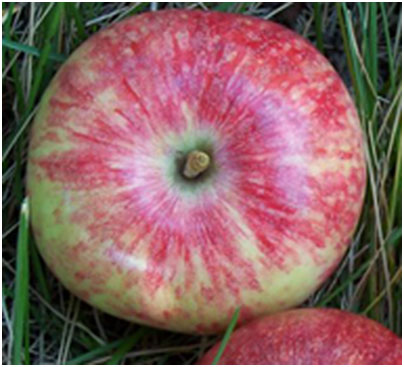
Battleford apple. This apple has been around since the late 50’s.
Apples for Cold Climates
Malus domestica
Overview
Apples are grafted -- they generally do not grow true from seed. The ones I bring in are grafted onto Dolgo crabapple rooting stock. These are full size trees -- they will get 25 feet tall and wide if you let them. Most people prune them back to keep them 12-15 feet high so they don't have to spend a month each year climbing ladders.
You need two different cultivars to get decent crops. One can be a crabapple. They don't have to be close -- within a city block of each other is fine. They do have to have overlapping bloom periods.
Apples should be pruned to 4-5 feet off the ground as they mature. Dropped fruit should be picked up before winter, as the fruit can act as overwintering ground for apple scab. Dropped fruit can also draw wasps and fruit flies.
Height is a matter of choice. Too low, and picking up fallen fruit is difficult. Too high, and you spend all your time on ladders. A reasonable compromise is to limb the tree to the point where you can ride your mower under it.
Pruning
In the first year, you need to make sure that the tree is developing a central leader. This means one dominant central axis branch.
In the second year, you should remove narrow angled branches (narrow angled branches mean branches that are less than 90 degree angles from the main axis). By this year you should have about 4 or 5 good placed branches which will become your scaffold branches
Year three you should remove suckers and water sprouts as well as bad branches (branches with narrow angles, crisscrossing branches etc)
Year four onward just do typical pruning to keep the tree the size you like, maintenance pruning etc. In general you want air and sunlight to easily reach the inside of the tree. Think in terms of a tree open enough to easily throw a tennis ball through it from any side.
Thinning
Fruit thinning may also be necessary. If your apple tree seems to be producing an abundance of apples one year and then none the next, or if you get lots of very small fruit, then fruit thinning may be required. In order to fruit thinly you can knock flowers off in the spring to reduce the amount of fruit that way or you can remove the fruit once it has started to develop. (I don't like flower thinning. Don't try this way unless you have an abundance of bees.) The general rule of thumb is one apple always a hands width away from the next apple. This is only necessary for apple apples, not crab apples.
If you want the largest apples, thin to 1 per fruit spur. If you want to maximize the amount of applesauce or juice, thin to 2 per spur. If spurs are really close together, stay with 1 per spur.
Don't bother to thin until the tiny apples are about pea sized. The tree will drop a bunch on it's own, somewhere between BB and large peppercorn size.
Harvesting
Hand pick the apples when you like the flavour. “Ripeness” is botanically classified when the seeds are dark brown. Having said that if you are happy with the flavour before that pick them when you're happy with it.
Twist and pull the apple when removing it from the tree. If you just straight pull the apple off you end up breaking off the fruit spur and removing some of the buds for next year.
Avoid dropping the apples as that will lead to bruising.
Picking early, while still fairly hard, will give you apples that keep longer, but won't taste quite as good. You may want to pick and label as various stages, and keep track of the dates to decide when to best pick. Cultivars
Prairie apples have a tendency to fall off the tree when ripe. This often bruises them which then requires that you salvage and preserve what you can. On possible way to deal with this: Buy a batch of 12 foot tarps when they go on sale. Tie one corner to the trunk at the lowest branch. Pull the kitty corner out from the tree and peg it down. Now pin down the other two corners.
The end result with 4 tarps: Most of the space under the tree has a tarp at least a foot off the ground. A falling apple has a chance of hitting the tarp, much like a not very bouncy trampoline, and rolling to the edge. This will also help with your control of apple maggot.
Pests
Apple Maggot Very similar to the cherry fruit fly. The fly lays eggs in the fruit and the fruit will have maggots on the inside when the fruit is cut open. Dealing with Apple Maggot requires a combination of prompt cleanup (no apples on the ground) traps to kill adults after they emerge, lures to entice them to lay their eggs on false apples, and kaolin spray to make red apples appear unattractive. Chickens can be part of the solution too, as they eat fallen fruit, and go after the grubs as they leave fruit to overwinter in the soil.
Fireblight This is a bacterial disease that gives the tree an appearance of being scaled by fire. This disease can be slowed down by removing the infected tissue. Cut 1 foot toward the root from the bottom most sign of infection, and sterilize pruners betweeen each cut. Burn trimmings. Fireblight thrives in high nitrogen conditions so be wary of your fertilizer use.
Apple Scab This a fungal disease that causes scabby patches on the apple fruits. This is more prevalent in wet years. Cleanup after the season (rake leaves, fallen fruit) helps. Spores on the ground are splashed into the tree by rain. Create a non-splash surface with fresh mulch shortly after leaf break.
Deer mice, voles, pocket gophers, and rabbits These animals like to snack on apple trees. Mice and voles and other rodents can girdle the lower stem of an apple tree causing the tree to die. Sections of plastic weeping tile split and placed around the trunk help with this, and with overzealous weedeater operators. Be sure there are lots of 1/4-3/8" vent holes in the pipe. White is better, if you can find it.
Deer (a.k.a. hoof rat) The only sure prevention is an 8 foot fence. Second best is to make a large stand of shrub willow and dogwood that they will go after instead. Having a dog with a strong prey drive helps.
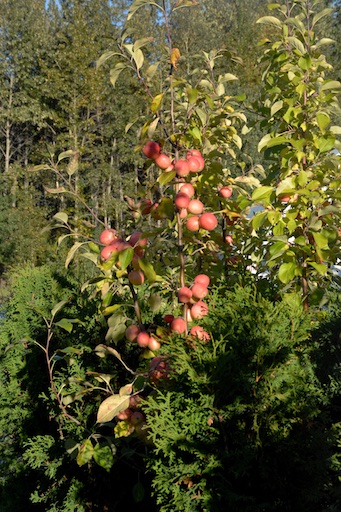
Norkent apples on the tree.
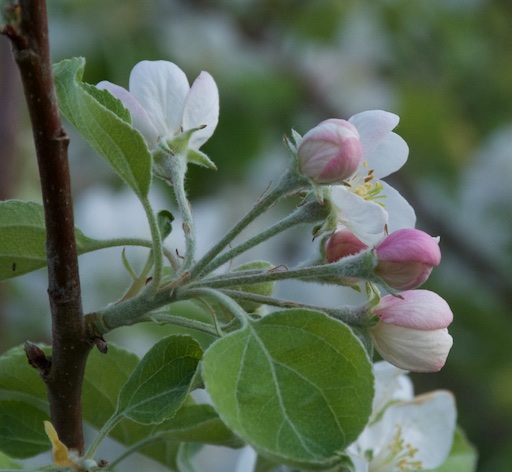
Apple Blossoms. Worth having the tree just for this.
Apples should be kept cold to store. Keeping them just above freezing will double their storage time compared to a 15 C (60 F) cellar. The adage about one bad apple spoiling the barrel is true. Periodically go through them, and separate any that are going soft.
Apples picked before peak ripeness will store better. In general hard apples keep better than soft ones; tart apples better than sugary ones.
Apples can readily be preserved as jelly, fruit butter, fruit chunks, apple sauce or pie filling. They can also be sliced and dried or pureed and made into fruit leather. If you have a lot of apples, consider making cider.
Applecrabs are hybrids between crabapples and apples. The fruit tends to be smaller, somewhat more tart. They tolerate a shorter growing season. Their smaller size makes them good snack and lunch box items for school lunches. Some of them are like gnawing on golf balls when they come off the tree. Store them for a few months, and they are quite good.
Crabapples are the smallest members of this group. Most are interspecies hybrids to the botanical name above doesn't fit. Fruit for eating crabs is typically about ping pong ball size or a bit smaller. You can make any crabapple into jelly, but picking tiny apples is time consuming. The red leaf crabs often have red fruit which makes for beautiful jelly if you have the patience to do the picking.
Apples and pears are both subject to fireblight. Some apples are immune, some are resistant in varying degree, some are very susceptable. A good article on it is here: Fire Blight of Apple And Pear
Our cultivars
Warning: I’ve gotten very mixed reports from reading different sources. One says, “resistant to fireblight” another says susceptible. One says, “Good keeper” another says “Keeps only 4 weeks” Do your homework. If you find more info, drop me a line.
Http://www.fruit.usask.ca/pfg_apples.html has a fair amount of information, but is not without it’s own contradictions. Note that the zones referred to are not always the Dept of Agriculture zones. See included map on their web page.
Battleford Apple: Zone 2. Battleford was first introduced in 1934, and is still used as a standard to compare other apples. Pale yellow skin, with red splash/stripes. Apples 6-7.5 cm (2.5 in.) in diameter. Ripens late August to mid September. Fair eating apple, good cooking and juicing apple. Keeps well for 4 weeks. Good resistance to fireblight. 15-18 feet tall x 12 feet across.
Norkent Apple: Zone 2b. Light green with prominent red streaks. Apples 7-8 cm (2.5 in.) in diameter. Ripens late August to mid September. Very good fresh eating, and baking. Fruit is crisp with a hint of pear flavour. Others compare it to Golden Delicious. Somewhat thick skinned. Susceptible to canker. Storage up to 12-14 weeks, but loses flavour as it ages. Fruit picked early lacks flavour.
Goodland Apple: Zone 3. Fruit 6-9 cm (2.5 - 3.5") Red, streaked with gren. Very good for fresh eating, and baking; good for juicing. Ripens mid September to Early October. Zone 3.
September Ruby Apple: Zone 2a. Fruit 6-7 cm (2.5 in. ) Red all over. Stores up to 16 weeks. Moderately resistant to fire blight.
Kerr Applecrab: Zone 3. Another traditional apple dating back to 1952. Apple is late ripening, (Late September, early October) but will stay on the tree far into fall, and tolerates heavy frost. A cross between Dolgo and Harlson. Fruit 5 cm. (2 in.) Red skin, yellow flesh, slightly acid. Good for fresh eating and canning, excellent for juice and jelly. Stores up to 27 weeks. Fair to good resistance to fireblight. Zone 3. I was told that these are very hard when picked, but soften in storage. My experience has been that they are good off the tree, if you leave them until after leaf drop to pick.
Odyssey Apple: Zone 3. Flavour comparable to Royal Gala. Green with red, white spots. Early ripening. (Late August according to some.) Stores 3-4 months. 20-30 feet tall x 10-20 feet wide if left to itself. 7-9 cm Red blush on yellow-green. Storage:good Zone 3.
Red Sparkle: Zone 2b Trail X MacIntosh. Flavour similar to MacIntosh with nutty overtones. White flesh. Very crisp and juicy. Medium sized (6 to 7.5 cm) green skinned apple, with red blush. Mid September ripening. Good fresh, good cooking apple. Ok for juice. So-so keeper (a few weeks refrigerated. Came out in 1990. Tree tends to sprawl, so shortening branches each year is recommended.
Gemini: Zone 2. Norland x Haralson. Crisp, juicy, medium sweetness. Yellow-green with red blush. Late August ripening. Stores into the new year under refrigeration. Fireblight resistent. Gets to 25-30 feet high if unpruned. Available also as a dwarf variety on Ottawa 3 rootstock. This version gets 12-15 feet high.
Red Gemini: Zone 2. Similar to Gemini overall, but with more red. Gemini and red gemini may be too closely related to be good cross pollenators.
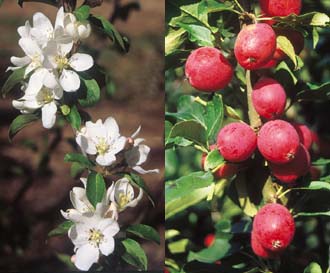
Dolgo Crabapple.
Dolgo Crabapple: Zone 2. Dolgo is a large eating crab, about the size of a ping pong ball, but somewhat football shaped. It's very sweet, and very red, making it attractive on the tree. It also keeps well, and is a good apple for canning whole.
Winter Cheeks Apple: Zone 3. Fruit:6-7.5 cm Red over pale yellow Ripens: Early September. Crisp, good flavour, good keeper.
Dwarf Varieties
I generally don't like dwarfs, as they require more attention. They are small because they are grafted onto a dwarfing root stock. So the roots become the limiting factor in their growth. This results in a tree with little drought tolerance. You must play close attention to keep it watered without overwatering.
As of early April 2019 I can get dwarf of:
- Dwarf Gemini Apple
- Dwarf Goodland Apple
- Dwarf Norkent Apple
- Dwarf Odyssey Apple
- Dwarf Prairie Magic Apple
- Dwarf Red Gemini Apple
These all come in #5 pots and will be about 4 feet tall, I think. 80 each.
In addition to the above, the following are available as special order, some are available in multiple sizes. Prices range from 90 to 140 for 6 foot tree to 1.5" caliper tree (12-14 feet)
- Gemini Apple
- Red Gemini Apple
- Prairie Magic Apple
- Red Sparkle Apple
If there is something else you want, inquire.
The list below is from my supplier. I can get these if you give me enough warning -- Too late right now (April 2019) for any not on the list above.
Prairie Magic Apple: Zone 3. Fruit:7-8 cm. Red blush on yellow Ripens: Mid-September Storage:Good Ripens mid September. Parentage: Goodland x Mantlet
Red Sparkle Apple: Zone 3 Fruit:6-7.5 cm Dark green over green Ripens: Early September Storage:Very Good Parentage: Trail x MacIntosh.
Gemini Apple: Zone 2. Fruit 7-8 cm red over pale yellow. Crispy, medium sweet. Ripens late August. Stores well to after Christmas. Parentage Norland x Haralson.
Red Gemini Apple: Zone 2. Fruit 6-7.5cm (2.25-3 inches) Red. Ripens late August. Stores well into the new year.
Rescue Applecrab: Zone 2 Fruit:3-4 cm red stripes on yellow Ripens: Late August Storage:Fair Origin: Scott Research station, SK 1936. Open pollenated offspring of Blushed Calville
Honeycrips Apple Zone 4. Fruit 7-8 cm Red over yellow. Exceptionally crisp and juicy. Not cold hardy for general prairie use. Sheltered metro areas only. Parentage Macoon x Honeygold
Apple Comparisons:
The ultimate comparison is to take yourself to the Fruit Festival at the U of A Botanical Gardens (Devonian Gardens) on the second Saturday of September. (14 September 2019) But you want to know now.
I asked this on Hardy Fruit and Nut trees of Alberta. Rather than digest it all, I thought I'd be lazy and just post their answers.
"Goodland and Norkent are pretty similar. Crispy and sour, but sweet enough to eat fresh. Also good for baking or cooking - like a slightly more sour gala apple."
-- TK
"KIK is so right!! I do not find goodland & Norkent sour, but a sweet tart. Norkent sweeter with a Golden Delicious flavor. Maybe check out the reviews on Orange Pippin tasting notes for some of you apples! My favorites of the ones you listed are Red Sparkle (smaller apple) & Wintercheeks which to me have a fruity sweet flavor. I find Odyssey which is reported to have a gala like flavor to be tough skinned and sweet with little flavor...could be my growing conditions."
Definitely different answers (could be the growing conditions also). I find Goodland tarter, but Prairie Sensation sweet and one of my favorites.
-- AL
"Norkent is hands down best eating apple, sweet & crisp, good keeping, makes awesome juice. September Ruby is more sour, also great juicing where Goodland is even more sour & tart...more of a cooking apple, but if tart is your thing then you’ll prefer this one and Prairie Sensation."
"A lot of people don’t realize that a mild Gala type Apple can’t be grown here..our growing climate is unique and most apples end up a little on the sour/ tart side. We find that Norkent has the least amount and that’s why we prefer it as best eating..all my 3 grown kids like this one over any store bought apples.
-- KIK
My own observations: I think of September Ruby as being sweeter, but more bland, not tart, not apply. For me, a yawner apple. Odyssey last year had fewer but larger apples than norkent. My biggest apple was a battleford, but that tree had only one apple. (These are young trees, often first year blooming. Kerr applecrab by one report is a very hard apple when picked, but is an excellent keeper. I found that if you wait until leaf fall or at least several hard frosts, it is sweet, crisp, and very appley in aroma and taste. Currently my favorite. I suspect that it depends on when picked.
--SGB
Got something to say? Email me: sfinfo@sherwoods-forests.com
Interesting? Share this page.
Want to talk right now? Call me: (8 am to 8 pm only, please) 1-780-848-2548
Do not arrive unannounced. Phone for an appointment. Why? See Contact & Hours That same page gives our hours of operation.
Back to Top
Copyright © 2008 - 2021 S. G. Botsford
Sherwood's Forests is located about 75 km southwest of Edmonton, Alberta. Please refer to the map on our Contact page for directions.
